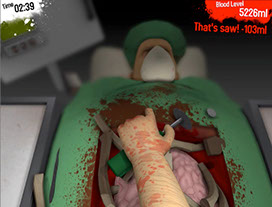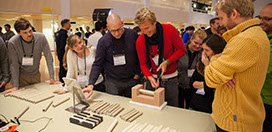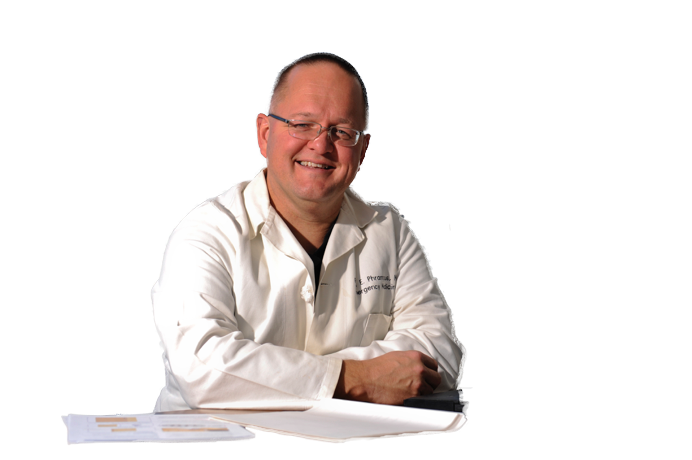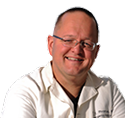Why simulation technologies are transforming medical education
The old adage “see one, do one, teach one” is becoming outdated. Rather than being the master's apprentice in their field, students are now more likely to practice, practice, and practice again according to certified standards.
Read an interview with Paul Phrampus, MD, the Director of the Peter M Winter Institute for Simulation, Education, and Research (WISER) at the University of Pittsburgh. He gives his recommendations for the implementation and management of medical simulation training programs.
Today’s simulations
Today’s human patient simulators can bleed, groan, and change vital signs like pulse, breathing, and blood pressure to simulate any number of medical conditions on demand.
E-learning and virtual simulations that can render lifelike, 3-D reconstructions of the entire human anatomy are now potentially available at all hours in flexible, self-paced learning modules.
Medical simulation training at Fort Jackson
Trauma simulations used in US army training
Standardized versus computer simulated patients
Mara McAdams, MD, Medical Director of the CPC at Duke-NUS in Singapore compares the benefits of using real people performing standardized patient roles as opposed to clinical sessions with the computer-simulated mannequin SimMan.
Simulation-Based Training at Duke-NUS
Mara McAdams, MD Medical Director of the CPC
So what is simulated medical training? There are many different ways to practice health care including consultations with actors pretending to be sick or sick people asking each intern the same questions, hands-on case studies using simulated mannequins in realistic health-care settings, or practicing surgical skills in fully virtual environments and even computer games.
With all these different ways of simulating medical care it seems challenging to find a starting point for systemization. In this article we outline the benefits, challenges, and best practice for simulations in health-care training.
WHY PRETEND?
The opportunity to practice and master real-world skills has proven benefits:
Safety
Simulation training was pioneered early last century by the aviation and military industries because something had to change: Too many pilots were dying.
Due to the popular belief that great pilots were born rather than made, too many flew off unprepared—and paid the price. Flight simulators saved countless lives by giving pilots the chance to safely practice dangerous challenges like landing in a fog or flying through the eye of a storm repeatedly until they mastered the task.
Many of these early simulation strategies were crude, the storm being no more than a few assistants rocking the plane, but with practice they showed results. These successes made people rethink how to teach and inspired efforts to apply simulation training to equally life-threatening medical challenges.
In part, the growing emphasis on systematic practice in medical training is a response to the disturbing realization that an alarming number of patients have died due to medical errors. At the start of this century reportedly 98,000 deaths could have been prevented, more than those attributed to motor accidents, breast cancer, and AIDS [1].
Medical education has been redesigned in order to fix this problem. Although simulations might have historically focused on psychomotor skills, today they also emphasize on the contextual application of key safety skills such as strategic decision making under pressure or teamwork in a crisis.
Relevance
Written textbooks are excellent reference materials, but do not tell the full story. Patients have personalities. A patient's recovery might be impaired due to their worries, or they might not notice their condition or ignore all advice until it is too late.
Administering health care to actual people is very different from writing a test. Written scenarios may fail to reveal every challenge a surgeon might face and as a result students may not notice the small cues that give away what is really going on.
Systematic and objective
Simulations on the other hand can help to fine tune complex health care practices. The ability to target, provoke, and record a range of conditions, including (in some fields) standard tests for certified practitioners, helps educators objectively assess competency as well as teach procedure.
Identical scenarios can be repeated infinitely. They can also be reset to expose those taking part to all sorts of unforeseen circumstances. As a result, weaknesses can be identified that might otherwise have gone unrealized. Those weaknesses can then be diminished in a workshop by using increasingly difficult challenges until participants attain the required competency levels [2].
The opportunity to get ahead and master essential career skills
Assessment is an essential learning tool for this sort of training. Deliberate practice focuses on achieving clear goals and improving performance [2,3]. In order to be clear those goal posts might define relevant procedures, rather than outcomes per se. Nevertheless, studies show that students exposed to appropriate and relevant scenario-based training end up with more skills than those who do not have the same opportunities [2,3].
Accessibility
Educators have always been able to use surrogate patients as a way to safely teach medical care, but this works only to a certain point. Broken bones and surgical incisions cannot be practiced on real patients, regardless whether they are surrogates or not. Computer technologies open up a new chapter in medical training. They are also increasingly affordable.
In the late nineties state-of-the-art mannequins might have cost $250,000 or more. The release of the first SimMan in 2001 for under $50,000 marked the beginning of a new era in medical care. Today, as real patient surrogates become less available due to safety concerns and shorter hospital stays, computerized simulations are becoming more sophisticated and accessible.
CHALLENGES
Cost
Computerized simulation equipment may cost less today, but simulations are still time and work intensive. Unlike classes where one lecturer can teach 20, or even 100 students, in practice-based training it is more likely that three or four faculty are required to facilitate small teamwork scenarios.
Developing the necessary skills to support these activities is equally time intensive. Digital learning support materials need to be developed specifically for the diverse curricula, maintained over time, and kept up to date with changing medical technologies. This demands substantive resources.
One solution is to share costs. For example educators involved in the Computer-assisted Learning in Pediatrics Program (CLIPP) collaboratively develop e-learning case studies for pediatric training [4]. These case sessions are used by more than 100 training institutions across America and Canada [4,5].
Know how
The real challenge, however, is not money or even technology; the real challenge is how to use simulation technologies effectively to train future health care providers. Past experience shows that simulations need to be structured in specific ways.
Top ten features of effective simulations
- Feedback: When assessment is also a learning tool, feedback is essential. Most of the learning occurs in debriefing sessions when students look at the recordings of simulated events and discuss the results. That feedback is most effective when it is provided on the spot and clearly points to what worked well, what needs to be changed, and how to change it.
- Repetitive practice: Applying what has been learned in the next simulation helps to reinforce it. This is also known as deliberate practice: A repetitive, focused practice based on measurable results and rigorous feedback.
- Curriculum integration: These outcomes need to be integrated into the overall curriculum so that they offer meaningful pathways for learning.
- Range of difficulty: Being able to modify difficulty levels to match the abilities of the students concerned is optimal. On this basis, the level of difficulty can slowly be increased to offer new challenges and help master the tasks.
- Multiple learning strategies: Blended learning strategies, including different ways of teaching and acquiring different complementary skill sets, build upon each other.
- Clinical variation: Variety is the spice of life and trains participants to cope with a multitude of situations.
- Monitored environments: A dedicated space where participants can learn by trial and error is vital.
- Individualized learning: Simulations can be standardized but individual learners also need to be able to personalize those scenarios through active participation.
- Defined outcomes: Simulated learning is more effective when students are given clearly defined goals and tangible outcome measures.
- Simulation validity: Simulations should closely resemble real world challenges, in order to yield results that are useful for practice[3,6].
What do learners want?
According to a recent survey [7] of medical undergraduate students using e-learning resources, most students prefer to undertake self-directed studies with virtual patients (VP) after a lecture. This method enables them to apply the information they received in class, which helps to bolster understanding and retention of knowledge.
If students know that this self-study will also be discussed in small, follow-up seminars, where they will be challenged to reflect upon their clinical reasoning during the simulation, they admit to take their VP self-study more seriously. After these discussions learners feel better prepared to apply new knowledge in a clinical environment with real patients.
Is it a game or a class?
 “Surgeon Simulator 2013 is hardly a simulation, but it makes medical malpractice an absolute delight…” GamespotComputer games and simulation training share similar features. They are both driven by feedback, have clear goals, and offer challenges that participants accomplish in order to progress through certain levels of achievement—but games serve vastly different ambitions.
“Surgeon Simulator 2013 is hardly a simulation, but it makes medical malpractice an absolute delight…” GamespotComputer games and simulation training share similar features. They are both driven by feedback, have clear goals, and offer challenges that participants accomplish in order to progress through certain levels of achievement—but games serve vastly different ambitions.
In Surgeon Simulator, for example, there are no instructions. Botching a life-threatening operation is all part of the fun. Do games like this still have a place in the classroom? YES.
Coupled with relevant curricular activities (like redesigning the game), deeper reflection, and guided discussion, this sort of humorous play can enliven the classroom [8].
Some games are already designed to inspire deeper thinking. Game-based learning theorist Nicola Whitton recommends adventure games for problem solving, role play for social skills, and strategy games for planning, judgment, and creative thinking [9].
The AO Skills Lab
 AO Foundation already used instruments and implants during the first AO course in 1960. Back then the participants practiced applying plates and screws to the bones of anatomical specimens. Since then AO constantly improved and furthered its hands-on approach to education. The AO Skills Lab is the latest simulation used by AOTrauma. It aims at teaching basic principles and practical know-how needed for live surgery in ten challenging stations.
AO Foundation already used instruments and implants during the first AO course in 1960. Back then the participants practiced applying plates and screws to the bones of anatomical specimens. Since then AO constantly improved and furthered its hands-on approach to education. The AO Skills Lab is the latest simulation used by AOTrauma. It aims at teaching basic principles and practical know-how needed for live surgery in ten challenging stations.
References
1. Kohn LT, Corrigan JM, Donaldson MS. To Err Is Human: Building a Safer Health System. Washington, D.C.: National Academies Press; 2000.
2. Alinier G. A typology of educationally focused medical simulation tools. Med Teach. 2007 Oct;29(8):e243–e250.
3. Issenberg SB, McGaghie WC, Petrusa ER, et al. Features and uses of high-fidelity medical simulations that lead to effective learning: a BEME systematic review. Med Teach. 2005 Jan;27(1):10–28.
4. Fall LH, Berman NB, Smith S, et al. Multi-institutional development and utilization of a computer-assisted learning program for the pediatrics clerkship: the CLIPP Project. Acad Med. 2005 Sep;80(9):847–855.
5. Berman NB, Fall LH, Chessman AW, et al. A collaborative model for developing and maintaining virtual patients for medical education. Med Teach. 2011;33(4):319–324.
6. Motola I, Devine LA, Chung HS, et al. Simulation in healthcare education: a best evidence practical guide. AMEE Guide No. 82. Med Teach. 2013 Oct;35(10):e1511–e1530.
7. Huwendiek S, Duncker C, Reichert F, et al. Learner preferences regarding integrating, sequencing and aligning virtual patients with other activities in the undergraduate medical curriculum: A focus group study. Med Teach. 2013 Nov;35(11):920–929.
8. Foster A, Shah M. PCaRD: A model for teachers to integrate games in their classrooms. Paper presented at: Society for Information Technology & Teacher Education International Conference; March 5, 2012; Austin.
9. Whitton N. Learning with Digital Games: A Practical Guide to Engaging Students in Higher Education. New York: Routledge; 2010.
 “With simulation we can customize continuing education programs for each individual.”
“With simulation we can customize continuing education programs for each individual.”
FacultyFocus spoke to Paul Phrampus MD, Director of the Peter M Winter Institute for Simulation, Education, and Research (WISER) at the University of Pittsburg, USA. WISER conducts research and training programs utilizing simulation based education to provide a safer environment for patients.
Dr. Phrampus, what does WISER provide in terms of medical simulation training?
At WISER we believe in a holistic model of education. To that end we bundle what people are now calling simulation with other modalities of learning. Out of our 140 courses that we offer here at WISER, 65% include online learning, interactive education, facilitated discussions and the like. We do not run the type of simulation software where people just interact with the mannequins and go away. Instead we design a curriculum that supports learning needs overall. We think that makes the simulation more efficient and more effective.
Are there particular scenarios that lend themselves to simulation?
It depends upon what you are trying to accomplish. Simulation can be used for practicing psychomotor skills, like learning how to tie a specific knot in surgery and developing the skills to actually do that. But surgery is also about more than tying knots. Surgeons have to make decisions. They have to be able to walk in a room and instantly analyze a situation and say I need this type of knot!
The ability to make that decision is a particular skill, however. The ability to tie that knot is a completely different skill. The surgeon might think that the two skills are bound together, because in their experience they are part of the same procedure. The education expert has to say Wait a minute. These are two different things that may need two different 'attack pieces'.
Some simulation equipment can do both. It can present a case that gives students the opportunity to identify which procedure they need to undertake and then also enable them to do that. As a result we can measure both the required critical thinking and the technical skill to accomplish that task. So situations where we need to analyze multi-step tasks lend themselves to simulation. If we need to examine both, critical thinking and psychomotor competence then simulation training is ideal.
Have you encountered any unexpected challenges during simulations?
In my training capacity I work a lot with practicing professionals. Many of them are here on their day off because they have to take the course. Sometimes they are angry about it, so I now spend a lot of time at the start of the day explaining why this is relevant to their practice. I am cautious to orient them to what we are about to do. I tell them explicitly what we can achieve and I take them through every phase of what the simulator does. I show them what it looks like when the tongue goes out. I show them what it looks like when the mouth clamps down. I show them the whole process to decrease any worry they might have that we are trying to trick them. I orient them to the environment before we put them in a real situation and have them do their thing.
Some people call it a fiction contract. Other people call it a psychological contract. In my opinion it is just part of what professionals deserve when we put them in this environment. That said, the students we are creating today regularly experience simulation as part of their education, so it is like second nature to them.
How do you integrate simulation training into the overall curriculum?
At WISER we work with clinical experts who bring their specialist knowledge to a course while we bring the simulation, education and project management expertise to that partnership. Our first priority is to analyze the learning objectives. We want to define them in granular detail. Is this pure knowledge? Is this skill? Is this a combination of the two and if so, what is the percentage of each? For example if a student needs to remember specific doses of medication then we are going to help build knowledge modules. We might suggest web-based education before they even enter the simulation lab. If a skill is required, maybe a skill in bag valve mass ventilation, for example, we can simulate that quite well, but we also shoot a video of a bag valve mass ventilation and we have the learner review that before they come in. This helps to prime them for the cognitive aspects of that process. By visualizing the skills ahead of time they have already got the imagined psychomotor skills in place when they arrive. We think that puts them ahead of the curve and can make the simulated aspects of their learning more efficient.
Do you have any advice about investing in simulation technology?
Part of the challenge with simulation training is that people can go to a conference and see what appears to be a very cool simulator that does amazing things. They immediately say Oh I love that! It seems so realistic! They come back and buy this simulator for $200,000 only to discover that their trainees already get plenty of practice in that area. They have just invested $200,000 on something that they do not actually need. So an honest needs analysis is imperative right from the start. The people buying the equipment also need to separate out what is knowledge and what is skill. They need to understand the competence stems. In the US, for example, just about every paper that comes out on patient safety and errors in health care points to issues with teamwork and communication as critical contributing factors. Yet in most medical schools these skills are still not being taught in a specific way, nor assessed to an agreed standard. Again, an informed needs analysis of the overall curriculum is essential in order to achieve the best investment strategy over time.
What is the future of simulation training?
I think simulation training is going to be increasingly integrated into all facets of education and health care. Simulations for critical events will be embedded in the daily routine of continuing practice as well. As we get better at data collection we will be able to track each physician’s performance metrics. How are they doing in infections? How are they doing in complications and overall experience? Then we can marry up that information with their work experience to better identify and match their needs. We can customize continuing education programs for each individual. That way we can decide do they need a simulation in trauma care of the thorax?
I look forward to that level of customization in the future. At the moment when somebody goes through continuing education it is not customized to his or her needs. Everybody has to do a hundred hours of whatever every two years, but what does that person really need? Why put them through continuing education of things they already do well? Let us expose them to things they do not do all the time and need to do better.
___________
About Paul Phrampus MD
Paul Phrampus is the Director of the Peter M. Winter Institute for Simulation, Education, and Research (WISER). He is currently an Associate Professor in the Departments of Emergency Medicine and Anesthesiology of the University Of Pittsburgh School Of Medicine. Paul Phrampus is a co-creator and course director of the internationally acclaimed simulation instructor training program called iSIM (Improving Simulation Instructional Methods). He co-chaired the 2011 International Meeting for Simulation in Healthcare (IMSH) and is an inaugural member of the editorial board of the journal Simulation in Healthcare.
Paul Phrampus, MD discusses the term simulation as it used in health care education.
AOSpine
www.aospine.org | education@aospine.org
Copyright © 2014 AO Foundation. All rights reserved.

